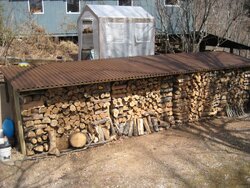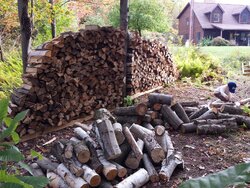I've been lurking on these forums for a while getting a lot of good info. I made a thread before about a BK Ashford which is going to arrive on October 10.
I had a few questions about firewood processing and drying. Last winter I ordered a load of log length firewood. I was told it was roughly 6 cords and paid $700 for it which seems not too bad to me. It was a mix of mostly cherry, maple, beech and some red oak. I split it in January and stacked it in single rows in the most open and windy place I have on my land. I've just started moving it into my wood shed and on fresh splits the moisture seems to range from 18-23% which seems good.
I'm trying to get a couple of years ahead and I want to process all my own wood and not need to buy it again. We have 23 acres of woodland around our house so we've no shortage of tress. I started cutting and I've cut, split and stacked about two cords so far for next winter. And I wanted to know how you guys do it who have your own wood lots.
Do you think it's best to haul the wood out and c,s,s it in the same area each year and then move it into the shed once dry? Do any of you c,s,s it in the woods and leave it to season in the woods and bring it out after a year or so of seasoning?
At the moment I have no means of hauling the firewood out of the woods. This weekend I cut the logs to size and carried them out by hand. Good exercise! Next year I'm going to get a quad bike with a trailer so I can use that to haul the wood out.
Thanks for any help and advice.
I had a few questions about firewood processing and drying. Last winter I ordered a load of log length firewood. I was told it was roughly 6 cords and paid $700 for it which seems not too bad to me. It was a mix of mostly cherry, maple, beech and some red oak. I split it in January and stacked it in single rows in the most open and windy place I have on my land. I've just started moving it into my wood shed and on fresh splits the moisture seems to range from 18-23% which seems good.
I'm trying to get a couple of years ahead and I want to process all my own wood and not need to buy it again. We have 23 acres of woodland around our house so we've no shortage of tress. I started cutting and I've cut, split and stacked about two cords so far for next winter. And I wanted to know how you guys do it who have your own wood lots.
Do you think it's best to haul the wood out and c,s,s it in the same area each year and then move it into the shed once dry? Do any of you c,s,s it in the woods and leave it to season in the woods and bring it out after a year or so of seasoning?
At the moment I have no means of hauling the firewood out of the woods. This weekend I cut the logs to size and carried them out by hand. Good exercise! Next year I'm going to get a quad bike with a trailer so I can use that to haul the wood out.
Thanks for any help and advice.



